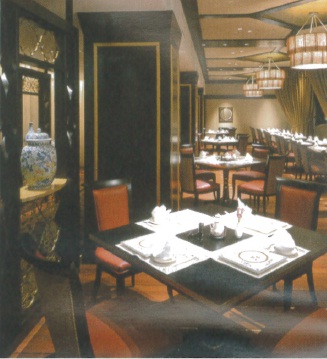by Christine Cunanan-Miki
Toh-Ka-Lin, the famed Cantonese restaurant of Hotel Okura, is not your typical Chinese dining establishment. This is apparent the moment you walk into the spacious main dining room, decked out in earthy autumn colors that soothe rather than stimulate. My husband said it reminded him of early 20th century aristocratic Shanghai — or at least what he thought it would have looked like — with its atmosphere of rich brocade and silks, coupled with ornately carved wooden dividers and blue and white porcelain vases.
The restaurant has always been a favorite choice of genteel Japanese families wishing to celebrate something special, or just with a sudden hankering for good Chinese food. On the weekday evening we were there, it was packed with people who looked like they were mostly dining with family or friends, including a grandmother with her daughter and two primary school grandsons, and a couple in their 70s who ate every bit of their seven-course meal. “This is in fact a rather quiet night, so we’re able to catch our breath,” our waitress told us. “You should see what it’s like on a weekend.”
Toh-Ka-Lin is not cheap, but we soon found out why so many diners are regulars. First, you get what you pay for, and here you’re assured of delicious freshness and generous servings. Our orders of shark’s fin soup each came with such a hefty, precious piece of fin that I actually had to cut mine into several pieces. A Cantonese-style sea bream sashimi appetizer arrived heaped with top-quality fish only sparingly laced with greens. A hot pot of braised lobster and noodles had an entire lobster that was so large I reluctantly left it half uneaten.
Chinese food can be heavy and starchy but, at Toh-Ka-Lin, the food is prepared in a Japanese way. Executive chef Liang Shu Neng is Chinese, but his creations have a more delicate taste and artistic arrangement than what you’d normally find in good Cantonese restaurants in Hong Kong or Guangzhou.
Unusually, Toh-Ka-Lin has its very own in-house patissier, ensuring that desserts are not just an afterthought, as in many other Chinese restaurants. We sampled a variety and found that most of the offerings — including the mango pudding and the fried sesame dumplings — were tasty but not overly sweet. The patissier’s piece de resistance is fried fruits served with honey (¥1,785 for a serving of one choice of fruit for two persons), an elaborate dessert that involves coating pieces of apple, banana, or sweet potato with hot caramel on a burner right next to your table. This was certainly a dramatic end to an evening of subtlety and refinement.
WHAT TO EAT
The set menus range from ¥ 8,400 to ¥31,500 per person, and you get a little hit of everything as part of an elaborate multi-course meal. We had the Kiku dinner menu (¥21,000 pel person), an excellent nine-course feast including shark’s fin soup, Peking clink, and sauteed fresh abalone and scallops.
WHAT TO DRINK
A 1989 vintage Chinese rice wine called Shao Sing Chiew (¥2,625 per glass), which is served at room temperature and has an alcohol content as strong as sake.
HOW MUCH DID IT COST?
Plan on spending at least ¥30,000 for a dinner for two, including several glasses of Shao Sing Chiew.
WHO TO ASK FOR
Most of the restaurant personnel speak English and are happy to assist.
Toh-Ka-Lin
Hotel Okura, 6F, Main Building
Tel. 03-3505-6068









